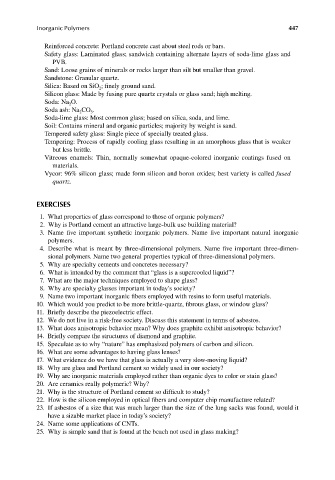Page 484 - Carrahers_Polymer_Chemistry,_Eighth_Edition
P. 484
Inorganic Polymers 447
Reinforced concrete: Portland concrete cast about steel rods or bars.
Safety glass: Laminated glass; sandwich containing alternate layers of soda-lime glass and
PVB.
Sand: Loose grains of minerals or rocks larger than silt but smaller than gravel.
Sandstone: Granular quartz.
Silica: Based on SiO ; finely ground sand.
2
Silicon glass: Made by fusing pure quartz crystals or glass sand; high melting.
Soda: Na O.
2
Soda ash: Na CO .
2 3
Soda-lime glass: Most common glass; based on silica, soda, and lime.
Soil: Contains mineral and organic particles; majority by weight is sand.
Tempered safety glass: Single piece of specially treated glass.
Tempering: Process of rapidly cooling glass resulting in an amorphous glass that is weaker
but less brittle.
Vitreous enamels: Thin, normally somewhat opaque-colored inorganic coatings fused on
materials.
Vycor: 96% silicon glass; made form silicon and boron oxides; best variety is called fused
quartz.
EXERCISES
1. What properties of glass correspond to those of organic polymers?
2. Why is Portland cement an attractive large-bulk use building material?
3. Name five important synthetic inorganic polymers. Name five important natural inorganic
polymers.
4. Describe what is meant by three-dimensional polymers. Name five important three-dimen-
sional polymers. Name two general properties typical of three-dimensional polymers.
5. Why are specialty cements and concretes necessary?
6. What is intended by the comment that “glass is a supercooled liquid”?
7. What are the major techniques employed to shape glass?
8. Why are specialty glasses important in today’s society?
9. Name two important inorganic fibers employed with resins to form useful materials.
10. Which would you predict to be more brittle-quartz, fibrous glass, or window glass?
11. Briefly describe the piezoelectric effect.
12. We do not live in a risk-free society. Discuss this statement in terms of asbestos.
13. What does anisotropic behavior mean? Why does graphite exhibit anisotropic behavior?
14. Briefly compare the structures of diamond and graphite.
15. Speculate as to why “nature” has emphasized polymers of carbon and silicon.
16. What are some advantages to having glass lenses?
17. What evidence do we have that glass is actually a very slow-moving liquid?
18. Why are glass and Portland cement so widely used in our society?
19. Why are inorganic materials employed rather than organic dyes to color or stain glass?
20. Are ceramics really polymeric? Why?
21. Why is the structure of Portland cement so difficult to study?
22. How is the silicon employed in optical fibers and computer chip manufacture related?
23. If asbestos of a size that was much larger than the size of the lung sacks was found, would it
have a sizable market place in today’s society?
24. Name some applications of CNTs.
25. Why is simple sand that is found at the beach not used in glass making?
9/14/2010 3:42:12 PM
K10478.indb 447 9/14/2010 3:42:12 PM
K10478.indb 447

